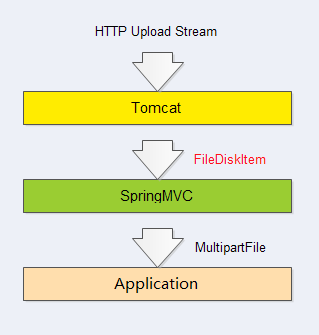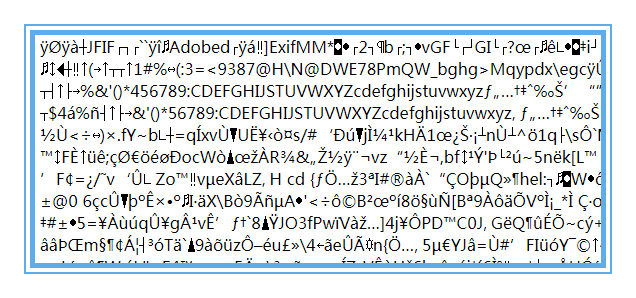一、文件上传原理
一个文件上传的过程如下图所示:

-
浏览器发起HTTP POST请求,指定请求头:
Content-Type: multipart/form-data -
服务端解析请求内容,执行文件保存处理,返回成功消息。
RFC1867 定义了HTML表单文件上传的处理机制。
通常一个文件上传的请求内容格式如下:
POST /upload HTTP/1.1
Host:xxx.org
Content-type: multipart/form-data, boundary="boundaryStr"
--boundaryStr
content-disposition: form-data; name="name"
Name Of Picture
--boundaryStr
Content-disposition: attachment; name="picfile"; filename="picfile.gif"
Content-type: image/gif
Content-Transfer-Encoding: binary
...contents of picfile.gif...
其中boundary指定了内容分割的边界字符串;
Content-dispostion 指定了这是一个附件(文件),包括参数名称、文件名称;
Content-type 指定了文件类型;
Content-Transfer-Encoding 指定内容传输编码;
二、springboot 文件机制
springboot 的文件上传处理是基于Servlet 实现的。
在Servlet 2.5 及早期版本之前,文件上传需要借助 commons-fileupload 组件来实现。
从Servlet 3.0规范之后,提供了对文件上传的原生支持,进一步简化了应用程序的实现。
以**Tomcat **为例,在文件上传之后通过将写入到临时文件,最终将文件实体传参到应用层,如下:

Tomcat 实现了 Servlet3.0 规范,通过ApplicationPart对文件上传流实现封装,
其中,DiskFileItem 描述了上传文件实体,在请求解析时生成该对象,
需要关注的是,DiskFileItem 声明了一个临时文件,用于临时存储上传文件的内容,
SpringMVC 对上层的请求实体再次封装,最终构造为MultipartFile传递给应用程序。
临时文件
临时文件的路径定义:
{temp_dir}/upload_xx_xxx.tmp
temp_dir是临时目录,通过 系统属性java.io.tmpdir指定,默认值为:
| 操作系统 | 路径 |
|---|---|
| windows | C:\Users{username}\AppData\Local\Temp\ |
| Linux | /tmp |
定制配置
为了对文件上传实现定制,可以在application.properties中添加如下配置:
//启用文件上传
spring.http.multipart.enabled=true
//文件大于该阈值时,将写入磁盘,支持KB/MB单位
spring.http.multipart.file-size-threshold=0
//自定义临时路径
spring.http.multipart.location=
//最大文件大小(单个)
spring.http.multipart.maxFileSize=10MB
//最大请求大小(总体)
spring.http.multipart.maxRequestSize=10MB
其中 maxFileSize/maxRequestSize 用于声明大小限制,
当上传文件超过上面的配置阈值时,会返回400(BadRequest)的错误;
file-size-threshold是一个阈值,用于控制是否写入磁盘;
location是存储的目录,如果不指定将使用前面所述的默认临时目录。
这几个参数由SpringMVC控制,用于注入 Servlet3.0 的文件上传配置,如下:
public class MultipartConfigElement {
private final String location;// = "";
private final long maxFileSize;// = -1;
private final long maxRequestSize;// = -1;
private final int fileSizeThreshold;// = 0;
三、示例代码
接下来以简单的代码展示文件上传处理
A. 单文件上传
@PostMapping(value = "/single", consumes = {
MediaType.MULTIPART_FORM_DATA_VALUE }, produces = MediaType.TEXT_PLAIN_VALUE)
@ResponseBody
public ResponseEntity<String> singleUpload(@RequestParam("file") MultipartFile file) {
logger.info("file receive {}", file.getOriginalFilename());
// 检查文件内容是否为空
if (file.isEmpty()) {
return ResponseEntity.badRequest().body("no file input");
}
// 原始文件名
String fileName = file.getOriginalFilename();
// 检查后缀名
if (!checkImageSuffix(fileName)) {
return ResponseEntity.badRequest().body("the file is not image");
}
// 检查大小
if (!checkSize(file.getSize())) {
return ResponseEntity.badRequest().body("the file is too large");
}
String name = save(file);
URI getUri = ServletUriComponentsBuilder.fromCurrentContextPath().path("/file/get").queryParam("name", name)
.build(true).toUri();
return ResponseEntity.ok(getUri.toString());
}
在上面的代码中,我们通过Controller方法传参获得MultipartFile实体,而后是一系列的检查动作:
包括文件为空、文件后缀、文件大小,这里不做展开。
save 方法实现了简单的本地存储,如下:
private String save(MultipartFile file) {
if (!ROOT.isDirectory()) {
ROOT.mkdirs();
}
try {
String path = UUID.randomUUID().toString() + getSuffix(file.getOriginalFilename());
File storeFile = new File(ROOT, path);
file.transferTo(storeFile);
return path;
} catch (IllegalStateException e) {
throw new RuntimeException(e);
} catch (IOException e) {
throw new RuntimeException(e);
}
}
B. 多文件上传
与单文件类似,只需要声明MultipartFile数组参数即可:
@PostMapping(value = "/multi", consumes = {
MediaType.MULTIPART_FORM_DATA_VALUE }, produces = MediaType.APPLICATION_JSON_UTF8_VALUE)
@ResponseBody
public ResponseEntity<List<String>> multiUpload(@RequestParam("file") MultipartFile[] files) {
logger.info("file receive count {}", files.length);
List<String> uris = new ArrayList<String>();
for (MultipartFile file : files) {
C. 文件上传异常
如前面所述,当文件上传大小超过限制会返回400错误,为了覆盖默认的行为,可以这样:
@ControllerAdvice(assignableTypes = FileController.class)
public class MultipartExceptionHandler {
@ExceptionHandler(MultipartException.class)
public ResponseEntity<String> handleUploadError(MultipartException e) {
return ResponseEntity.badRequest().body("上传失败:" + e.getCause().getMessage());
}
}
D. Bean 配置
SpringBoot 提供了JavaBean配置的方式,前面提到的几个配置也可以这样实现:
@Configuration
public static class FileConfig {
@Bean
public MultipartConfigElement multipartConfigElement() {
MultipartConfigFactory factory = new MultipartConfigFactory();
factory.setMaxFileSize("10MB");
factory.setMaxRequestSize("50MB");
return factory.createMultipartConfig();
}
}
四、文件下载
既然解释了文件上传,自然避免不了文件下载,
文件下载非常简单,只需要包括下面两步:
- 读文件流;
- 输出到Response;
这样,尝试写一个Controller方法:
@GetMapping(path = "/get")
public ResponseEntity<Object> get(@RequestParam("name") String name) throws IOException {
...
File file = new File(ROOT, name);
if (!file.isFile()) {
return ResponseEntity.notFound().build();
}
if (!file.canRead()) {
return ResponseEntity.status(HttpStatus.FORBIDDEN).body("no allow to access");
}
Path path = Paths.get(file.getAbsolutePath());
ByteArrayResource resource = new ByteArrayResource(Files.readAllBytes(path));
return ResponseEntity.ok().contentLength(file.length()).body(resource);
}
这段代码通过参数(name)来指定访问文件,之后将流写入到Response。
接下来,我们访问一个确实存在的文件,看看得到了什么?

…
!! 没错,这就是文件的内容,浏览器尝试帮你呈现了。
那么,我们所期望的下载呢? 其实,真实的下载过程应该如下图:

区别就在于,我们在返回响应时添加了Content-Disposition头,用来告诉浏览器响应内容是一个附件。
这样根据约定的协议,浏览器会帮我们完成响应的解析及下载工作。
修改上面的代码,如下:
@GetMapping(path = "/download")
public ResponseEntity<Object> download(@RequestParam("name") String name) throws IOException {
if (StringUtils.isEmpty(name)) {
return ResponseEntity.badRequest().body("name is empty");
}
if (!checkName(name)) {
return ResponseEntity.badRequest().body("name is illegal");
}
File file = new File(ROOT, name);
if (!file.isFile()) {
return ResponseEntity.notFound().build();
}
if (!file.canRead()) {
return ResponseEntity.status(HttpStatus.FORBIDDEN).body("no allow to access");
}
Path path = Paths.get(file.getAbsolutePath());
ByteArrayResource resource = new ByteArrayResource(Files.readAllBytes(path));
return ResponseEntity.ok().header("Content-Disposition", "attachment;fileName=" + name)
.contentLength(file.length()).contentType(MediaType.APPLICATION_OCTET_STREAM).body(resource);
}
继续尝试访问文件,此时应该能看到文件被正确下载了。
小结
文件上传开发是Web开发的基础课,从早期的Servlet + common_uploads组件到现在的SpringBoot,文件的处理已经被大大简化。
这次除了展示SpringBoot 文件上传的示例代码之外,也简单介绍了文件上传相关的协议知识点。对开发者来说,了解一点内部原理总是有好处的。
本文来自"美码师的补习系列-springboot篇" ,如果觉得老司机的文章还不赖,欢迎关注分享-

 随时随地看视频
随时随地看视频




